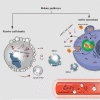The Role of Mitochondria-Targeting miRNAs in Intracerebral Hemorrhage
- PMID: 35524670
- PMCID: PMC10286585
- DOI: 10.2174/1570159X20666220507021445
The Role of Mitochondria-Targeting miRNAs in Intracerebral Hemorrhage
Abstract
Non-traumatic intracerebral hemorrhage (ICH) is the most common type of hemorrhagic stroke, most often occurring between the ages of 45 and 60. Arterial hypertension (AH) is most often the cause of ICH, followed by atherosclerosis, blood diseases, inflammatory changes in cerebral vessels, intoxication and vitamin deficiencies. Cerebral hemorrhage can occur by diapedesis or as a result of a ruptured vessel. AH is difficult to treat, requires surgery and can lead to disability or death. One of the important directions in the study of the pathogenesis of ICH is mitochondrial dysfunction and its regulation. The key role of mitochondrial dysfunction in AH and atherosclerosis, as well as in the development of brain damage after hemorrhage, has been acknowledged. MicroRNAs (miRNAs) are a class of non-coding RNAs (about 18-22 nucleotides) that regulate a variety of biological processes including cell differentiation, proliferation, apoptosis, etc., primarily through gene repression. There is growing evidence to support dysregulated miRNAs in various cardiovascular diseases, including ICH. Further, the realization of miRNAs within mitochondrial compartment has challenged the traditional knowledge of signaling pathways involved in the regulatory network of cardiovascular diseases. However, the role of miRNAs in mitochondrial dysfunction for ICH is still under-appreciated, with comparatively much lesser studies and investigations reported, than those in other cardiovascular diseases. In this review, we summarize the up-to-date findings on the published role miRNAs in mitochondrial function for ICH, and the potential use of miRNAs in clinical settings, such as potential therapeutic targets and non-invasive diagnostic/prognostic biomarker tools.
Keywords: Intracerebral hemorrhage; biomarker; miRNA; mitochondria; mitochondrial dysfunction; pathogenesis; therapeutic target.
Copyright© Bentham Science Publishers; For any queries, please email at epub@benthamscience.net.
Conflict of interest statement
The authors declare no conflict of interest, financial or otherwise.
Figures


Similar articles
-
MiRNAs as potential therapeutic targets and biomarkers for non-traumatic intracerebral hemorrhage.Biomark Res. 2024 Feb 2;12(1):17. doi: 10.1186/s40364-024-00568-y. Biomark Res. 2024. PMID: 38308370 Free PMC article. Review.
-
[MicroRNA and their potential role in the pathogenesis of hemorrhagic stroke].Zh Vopr Neirokhir Im N N Burdenko. 2020;84(1):86-93. doi: 10.17116/neiro20208401186. Zh Vopr Neirokhir Im N N Burdenko. 2020. PMID: 32207747 Russian.
-
MicroRNAs modulate neuroinflammation after intracerebral hemorrhage: Prospects for new therapy.Front Immunol. 2022 Nov 1;13:945860. doi: 10.3389/fimmu.2022.945860. eCollection 2022. Front Immunol. 2022. PMID: 36389834 Free PMC article. Review.
-
Plasma miR-124 Is a Promising Candidate Biomarker for Human Intracerebral Hemorrhage Stroke.Mol Neurobiol. 2018 Jul;55(7):5879-5888. doi: 10.1007/s12035-017-0808-8. Epub 2017 Nov 3. Mol Neurobiol. 2018. PMID: 29101647 Free PMC article.
-
Targeting the multifaceted roles of mitochondria in intracerebral hemorrhage and therapeutic prospects.Biomed Pharmacother. 2022 Apr;148:112749. doi: 10.1016/j.biopha.2022.112749. Epub 2022 Feb 24. Biomed Pharmacother. 2022. PMID: 35219118 Review.
Cited by
-
Mitochondrial Medicine for Neurological Disorders.Curr Neuropharmacol. 2023;21(5):1024-1025. doi: 10.2174/1570159X2105230320095644. Curr Neuropharmacol. 2023. PMID: 37203188 Free PMC article. No abstract available.
-
A pH-sensitive liposomal co-delivery of fingolimod and ammonia borane for treatment of intracerebral hemorrhage.Nanophotonics. 2022 Nov 2;11(22):5133-5142. doi: 10.1515/nanoph-2022-0496. eCollection 2022 Dec. Nanophotonics. 2022. PMID: 39634303 Free PMC article.
-
Targeting microRNA methylation: Innovative approaches to diagnosing and treating hepatocellular carcinoma.Noncoding RNA Res. 2024 Dec 14;11:150-157. doi: 10.1016/j.ncrna.2024.12.002. eCollection 2025 Apr. Noncoding RNA Res. 2024. PMID: 39829957 Free PMC article. Review.
-
MiRNAs as potential therapeutic targets and biomarkers for non-traumatic intracerebral hemorrhage.Biomark Res. 2024 Feb 2;12(1):17. doi: 10.1186/s40364-024-00568-y. Biomark Res. 2024. PMID: 38308370 Free PMC article. Review.
-
Mechanism and treatment of intracerebral hemorrhage focus on mitochondrial permeability transition pore.Front Mol Neurosci. 2024 Jul 31;17:1423132. doi: 10.3389/fnmol.2024.1423132. eCollection 2024. Front Mol Neurosci. 2024. PMID: 39156127 Free PMC article. Review.
References
Publication types
MeSH terms
Substances
LinkOut - more resources
Full Text Sources
Medical

